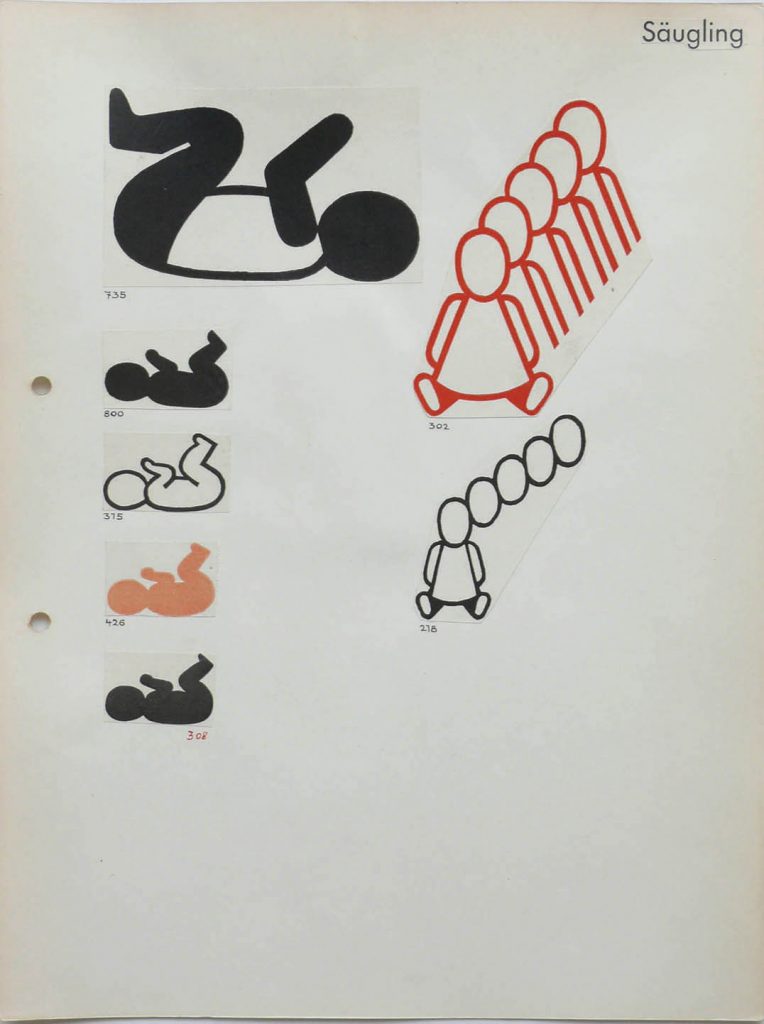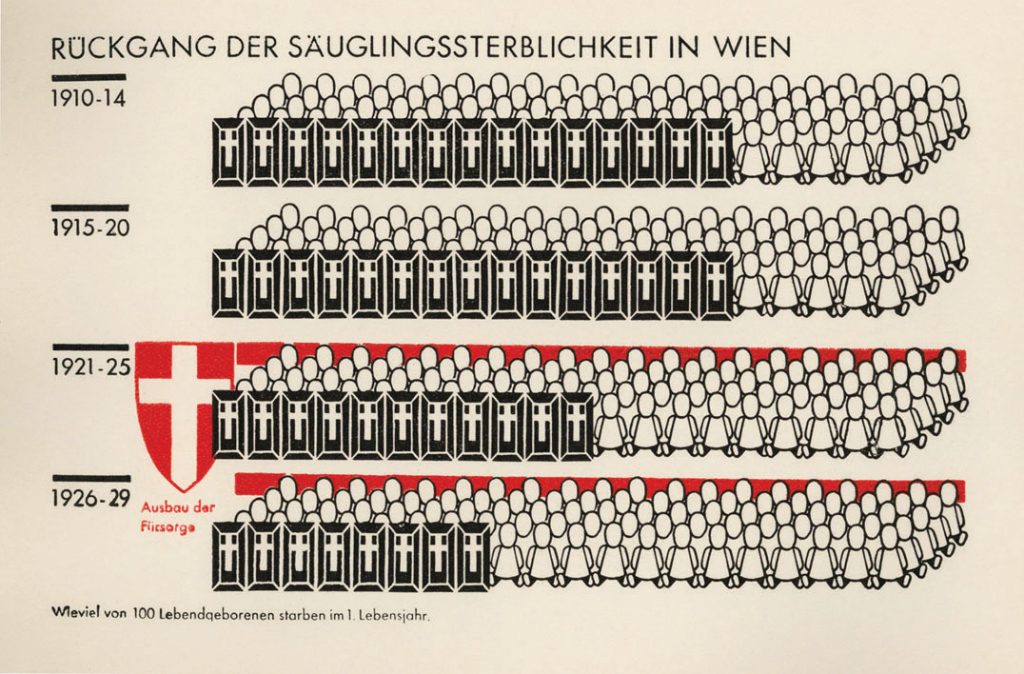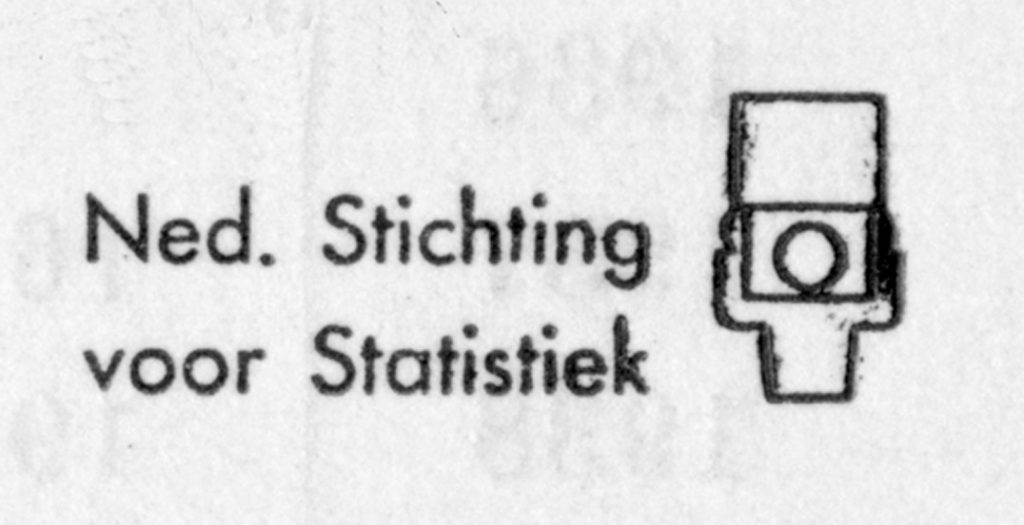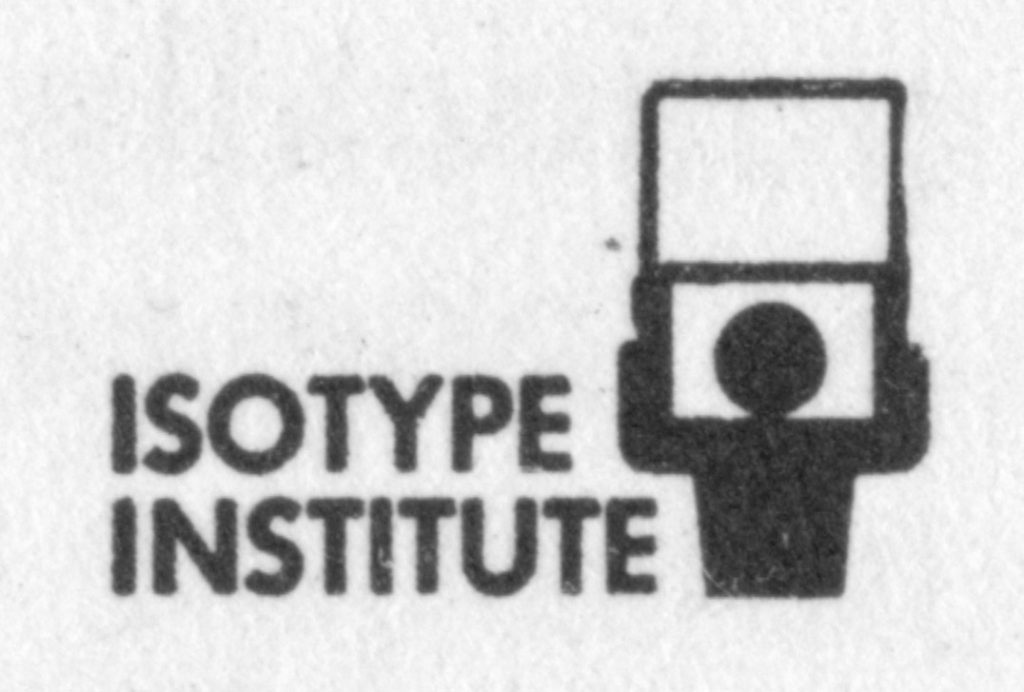This article follows on from the more general considerations on copyright in Isotype published here.
Publishers of translated editions of our book The transformer have told me that the estate of Gerd Arntz is claiming copyright in Isotype work published during the years in which Arntz was employed by the Gesellschafts- und Wirtschaftsmuseum in Wien [GeWiMu] (1927–34) and the International Foundation for Visual Education [IFVE] (1934–40). This refers to the work produced collectively and signed by these organizations, and not to the paintings or prints made and signed only by Gerd Arntz, about which there is no dispute.
My view is the same as that of Otto Neurath. This was collaborative work, and no individual could hold copyright in any part of it. This includes the pictograms that were drawn for it, and which were drawn as part of a collaborative process. The artists who drew the pictograms worked in dialogue with, and were partly instructed by, the person that was known in the group as the ‘transformer’. The transformer worked with raw material, turning it into a visual configuration, and made directions to the artists for what kind of pictograms they should draw.1 Otto Neurath was always careful to give credit to the group of people that made the work and never claimed rights for himself (see the appendix, below). The rights in this work were always assumed to belong to the organizations that made it.
The claim of the Arntz estate is that the Nederlandse Stichting voor Statistiek, founded in 1940 and Arntz’s employer in 1940–3 and again after 1946, held copyright in the pictograms used in this work. In 2011 the Arntz estate bought this putative copyright from the successor to the NSS, the company now called Synovate Interview / NSS bv.2
‘Neurath and Arntz’
Behind the Arntz estate’s claim lies a view of Isotype work that has prevailed in the Netherlands and which has been uncritically picked up elsewhere. The work is seen as the joint creation of Otto Neurath and Gerd Arntz; no one else is imagined to have played any significant creative part. The pictograms that were drawn by Arntz are seen in a continuum with his artistic work. The romantic view of the artist as a free creator colours this view and ignores the fact that these pictograms were shaped by specific requirements, and that all those who made this work were paid employees. A glance at the ‘picture dictionaries’ assembled in the course of the work shows that these pictograms were indeed made to fit a larger whole, which was designed by a transformer and not the graphic artists who drew pictograms. Slightly varying pictograms were made for different charts, at different sizes and printed in different colours.

A sheet of ‘infant’ pictograms in the ‘picture dictionary’ of the GeWiMu and IFVE. Pictograms were given numbers and prints from the printing blocks were pasted there; colours actually used in the charts were retained in these prints.

A chart that uses one of the infant pictograms. The idea of having a ‘fivefold’ unit would have come from the transformer, not the artist.
The idea that the work of the GeWiMu and the IFVE was made by ‘Otto Neurath and Gerd Arntz’ dates back to the 1970s, when it was being rediscovered. In 1982 in Vienna, Friedrich Stadler organized the exhibition titled Arbeiterbildung in der Zwischenkriegszeit: Otto Neurath – Gerd Arntz. The two were linked together as equal protagonists.

Cover of the ‘Arbeiterbildung in der Zwischenkriegszeit’ publication, accompanying the exhibition in Vienna, 1982
In the immediate background to the present claims of the Arntz estate lies the work of the designer Ed Annink (1956–2012), who was able to exploit the pictograms drawn by Arntz in a spirit of celebration and historical innocence. Annink and his writer, the journalist Max Bruinsma, made the Gerd Arntz web archive, which features a large selection of the pictograms drawn by Arntz for the GeWiMu, the IFVE, and the NSS – mixed together (‘Period: 1928–1965’) in disregard of history. The colours that were used for the original printings of these pictograms are retained, unexplained. This serious work is thus reduced to decoration and fodder for commercial exploitation.3 In the account of Annink and Bruinsma, the creators of Isotype were ‘Neurath and Arntz’. The Arntz estate now uses this website uncritically, without revision to it.
Annink compiled two books that feature this work: Lovely language (Rotterdam: Veenman, 2008) and Gerd Arntz: graphic designer (Rotterdam: 010 Publishers, 2010). I discussed these books in articles published on this website: here and here.
A response to the claims of the Arntz estate
The claims of the Arntz estate have been made by John van der Ree, its advisor, in emails to me and to Eric Kindel and Christopher Burke at the University of Reading. What follows is a response to the account that he has given. I am making this response in public now, so that anyone intending to reproduce Isotype work can take a view of the validity of the claims of the Arntz estate.
In their lifetimes, neither Otto Neurath nor Gerd Arntz, nor any other of the people who made this work, laid any claim to copyright in it. Copyright was always assumed to lie with the producing organizations that employed them.
The recent copyright claim of the Arntz estate seems to lie in events that followed from the German invasion and occupation of the Netherlands in May 1940. Otto Neurath and Marie Reidemeister (later Marie Neurath, after her marriage to Otto Neurath in 1942) escaped to England; Gerd Arntz and Josef Scheer (another IFVE employee, who had come with the group from Vienna), remained in the Netherlands.
The events that followed are described in letters written in 1945, in the immediate aftermath of the war, by Dr P.J. de Kanter, one of the members of the board of the International Foundation for Visual Education, to Otto Neurath, now in England.4
A new body, the Nederlandse Stichting voor Statistiek, had been created by agreement between the Centraal Bureau voor de Statistiek [CBS] and the IFVE. This was done for the mutual benefit of the CBS, which would add visual presentations to its reports, and the IFVE, which would thereby keep Isotype methods alive and out of the hands of the German occupying forces; and it would give paid employment to Gerd Arntz.
Three members of the IFVE board (Dr and Mrs de Kanter, and Prof. Jan Tinbergen – who also worked for the CBS) met and agreed the following: ‘the material of both foundations was sold and the copyright in Isotype methods and symbols transferred to NSS.’ De Kanter added: ‘Not to give the Germans any handhold over us we considered you and your present wife as having resigned from your offices in both foundations. These then went to sleep.’ But Otto Neurath and Marie Reidemeister were still alive, and would never have agreed to such a sale of materials and transfer of copyright.5 The constitution of the IFVE required that its director, Otto Neurath, should approve and sign any such resolution.6 So this resolution was passed with just the agreement of three directors of the IFVE, one of whom also worked for the NSS, and without the agreement of its director.
Otto Neurath died in December 1945. Marie Neurath continued their work, and began to deal with the implicit challenge that the NSS now represented: it was using the same materials and the same methods that she and the other members of the team had developed since 1925. Matters came to a head in 1947. The NSS refused to give up its rights to the use of Isotype materials. A simple solution was found. The NSS had been using the Isotype symbol on its work. Arntz now designed a new symbol for the NSS. The Isotype Institute in England continued to use the symbol that Arntz had designed for the IFVE in 1935.




Symbols: IFVE 1935 | NSS 1940 | NSS 1947 | Isotype Institute 1942
The two bodies then coexisted without conflict: each worked in its own language-sphere, and also the Isotype Institute worked increasingly in contexts beyond the strictly statistical sphere that the NSS occupied.
Summary
The claim of the Arntz estate now falls into place. The situation can be summarized thus:
1. The work was done by people employed by a succession of organizations. Copyright in the materials of this work was never assigned to any individual. To see rights in any part of this work as belonging to an individual is a misconception.
2. In 1940, in wartime and under conditions of duress, board members of the IFVE sold rights to an organization that they imagined would continue the work of the IFVE. Though understandable in those circumstances, their action contravened the statutes of the IFVE. The board members did not know that Otto Neurath and Marie Reidemeister were alive and were in England, restarting their work with a new body (the Isotype Institute).
3. After the war, no agreement could be reached to give back sole rights in Isotype to Otto Neurath and Marie Neurath’s continuation body (the Isotype Institute). The NSS and the Isotype Institute then coexisted, without challenge from one to the other.
4. John van der Ree, for the Arntz estate, reports that it has bought the rights in Isotype work from the successor body to the NSS. During the lifetimes of the people who were most central to its production – Otto Neurath (1882–1945), Marie Reidemeister/Neurath (1898–1986), Gerd Arntz (1900–88) – and for years afterwards, no individual tried to claim copyright in any part of the work. It is only now, in 2017, that the grandchildren of one of these people have generated a claim.
5. The claim of the Arntz estate to rights in Isotype work is based on a misconception of the work and is not supported by the facts of the work’s history. There was no individual copyright to buy (point 1), and the recent purchase of it (point 4) is based on the illegitimate purchase of it in 1940 (point 2). This claim is without merit and should be ignored by anyone to whom it is made.
Appendix: how Otto Neurath credited the team
1933: Bildstatistik nach Wiener Methode in der Schule (Vienna & Leipzig: Deutscher Verlag für Jugend und Volk) p. 3
Der Dank aller, die sich heute dieser Methode bedienen, gebührt der ganzen Arbeitsgemeinschaft, innerhalb deren Friedrich Bauermeister und Marie Reidemeister seit Jahren die wissenschaftliche Organisation und die verantwortungsvolle Transformation ausgestalten halfen, während Gerd Arntz, von der ‘soziologischen Graphik’ kommend, und Erwin Bernath sich um die strenge Klarheit und gewinnende Einfachkeit der Mengenbilder verdient machten. Dank gebührt allen wissenschaftlichen Spezialisten, von denen Robert Bleichsteiner, Alois Fischer und Karl Peucker heute noch dauernd mitarbeiten.
[The thanks of all those who now follow this method are due to the whole team, within which Friedrich Bauermeister and Marie Reidemeister have for years helped to establish the scientific organization of content and its responsible transformation, while Gerd Arntz, coming from the ‘sociological’ graphic artists, and Erwin Bernath have worked to achieve the severe clarity and attractive simplicity of the pictorial statistics. Thanks are due to all the scientific specialists, among whom Robert Bleichsteiner, Alois Fischer and Karl Peucker still carry on their work with us.]
1936: International picture language (London: Kegan Paul), p. 10
A number of persons have given their support to the building up of the system; some of them are working together today as the chief group in the Mundaneum Institute The Hague: Marie Reidemeister, putting material together and making the ‘transformations’; Gert Arntz and Erwin Bernath designing the signs and making the pictures; Josef Scheer printing, colouring, and helping generally. From the very start Josef Frank has been our regular expert on the building and organization of museums.
1939: Modern man in the making (New York & London: Alfred A. Knopf), p. 159
I should like to acknowledge the work of my collaborators in the International Foundation for Visual Education, who aided me in expressing my statements by means of the picture-text style: Gerd Arntz, chief of the graphic department, whose genius as we evolved the Isotype method, supported by other designers, created its graphic style; Miss Marie Reidemeister, who has worked with me from the beginning of our pedagogical and scientific activities, and who, as chief of the transformation department, with her combination of scientific judgement and ability for visualization, did the preparatory work. I should like to thank not only these and other present collaborators of the Institute but also all those who helped to build up our method and to develop our style during the last fifteen years.
Acknowledgement
I thank Christopher Burke and Eric Kindel, both at the University of Reading, for their help and advice in writing this. Responsibility for this document is mine alone.
The sheet of pictograms and the chart using them are in the Otto & Marie Neurath Isotype Collection, University of Reading.
————————————————————
Robin Kinross
————————————————————
Notes
- When I met Arntz in 1976 and again in 1982, he told me that his work with Otto Neurath involved strong arguments. He felt relieved when he could work free of Neurath’s persistent engagement. Nevertheless it is clear that the great distinction of Arntz’s work with Neurath was a product of such arguments. Arntz’s pictogram work in the 1950s and 1960s seems weak by comparison.
- Email from John van der Ree to Eric Kindel (University of Reading), 21 August 2017.
- Annink designed doormats made from two of these pictograms. They are still for sale: follow the link on the home page of the Arntz website.
- See especially the three-page typescript headed ‘The situation in Holland’, held within a collection of material titled ‘Unterlage und Belege zur “Isotype Institute Ltd” ’, Österreichische Nationalbibliothek, Sammlung von Handschriften und alten Drucken, Cod. Ser. n. 31897 (see here). The quotations I make are from a letter from Dr P.J. de Kanter to Otto Neurath, dated 18.7.1945, which is extracted in this document.
- In my first meeting with Arntz (The Hague, 24.3.1976), he told me that he was not sure what had happened to Neurath and Reidemeister after May 1940. Eventually, stories began to come back (via someone Sweden) that they were alive and in England. Arntz assumed that they would return to the Netherlands when the war was over. He told me that during the war years he continued to work as if Neurath and Reidemeister were still there and that they would all resume their collaboration later.
- Another document in the same collection of material in the ÖNB (see note 4), gives a translation into English of the founding constitution of the IFVE (25.7.1933). Article 6 reads:
‘The representation of the Foundation is vested in the chairman of the Board, should he be prevented in the vice-chairman. Legal resolutions, communications and announcements need, to be valid, the signature of the chairman (or vice-chairman) of the Board and of the Director. The Board is entitled to all activities which are not expressly reserved for the General Assembly.’
Lacking the signature of the director (Otto Neurath), the sale of rights to the NSS in 1940 was thus legally invalid.